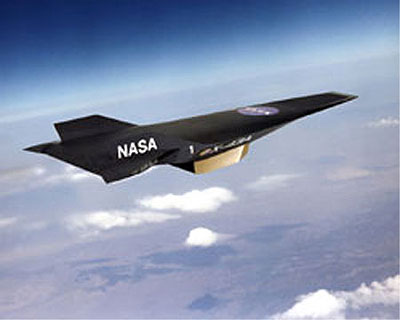
Direct link to this page: https://www.hayadan.org.il/hyperx181104.html
An unmanned aircraft of the American space agency NASA, managed to reach a speed of 11 thousand km/h, which is almost ten times the speed of sound.
''Once again we managed to make history. We did this in March when we reached seven times the speed of sound, and now we have reached a speed of ten times the speed of sound,'' said Vince Rausch, project manager on behalf of NASA.
This is the third phase of the Hyper-X project, which is intended for the development of supersonic missiles and aircraft. The results of the project for the development of breathing engines could be a flight from Israel to India in half an hour, and a far-reaching change in global traffic habits. Also, the project will allow a missile that leaves Texas to reach Washington in about 3 minutes.
The plane in question is a plane without a pilot and it could reach a speed of ten times the speed of sound only under special conditions. The 52-B bomber carried the plane up to a height of about 10 km, and from there the X-43A launched itself up, and only when it reached a height of about 30 km above the earth's surface did the plane manage to reach the desired speed.
The dream of the two-hour flight from New York to Sydney is approaching - a plane has reached a speed of Mach 10
From the New York Times

The "Pegasus" rocket with the NASA X-43A plane on it, yesterday
Photo: E.P
A small, unmanned NASA aircraft, which is 3.7 meters long, broke the speed record for jet aircraft yesterday, when it crossed the sky over the Pacific Ocean at a speed of close to Mach 10 - almost ten times the speed of sound. According to project managers, the aircraft, an X-43A, accelerated to a speed of nearly 10,621 km/h in a short test flight of the experimental scramjet engine, before performing a series of high-speed maneuvers while plunging and crashing into the ocean.
Yesterday's flight was the last of three test flights carried out by the X-43A plane, designed to prove that the innovative supersonic jet engine can operate at high speed and high altitude. The advantage of scramjet engines becomes apparent after they are accelerated to about Mach 4. The scramjet engine is able to compress air - which is essential for the process of burning the fuel in the engine (in this case hydrogen) - at supersonic speeds. This eliminates the need to carry heavy liquid oxygen tanks, which missiles and rockets need.
Project managers say the achievement is a significant step toward future developments of hypersonic aircraft and missiles, as well as cheaper launchers for sending payloads into space that can be reused. Experts have even estimated that scramjet engines will make it possible to build passenger planes in the future that can reach any destination in the world within two to three hours.
"Absolutely, but we'll have to wait," said Joel Sits, director of the X-43A project. "It took a long time from the Wright brothers to the first transatlantic flight. It may be a long time before this technology can be applied to passenger planes, but I think one day it will come."
Researchers and engineers said that the flight yesterday, which left the "Dryden Flight Research Center" in California, a NASA facility, and another flight carried out by an X-43A aircraft in March, proved the feasibility of the idea and showed that hypersonic flights are possible.
X-43A was installed in the front of the "Pegasus" rocket and both were carried yesterday under the wing of a B-52 aircraft up to a height of 40,000 feet (12 km) above the coast of Southern California. At this height, the plane and the rocket were released, which ignited and carried it for about 80 seconds to an altitude of 111,000 feet (33.5 km), while accelerating the plane to a speed of almost Mach 10. Then the X-43A separated from the rocket and continued to fly for another 10 seconds using the special scramjet engine, while achieving a speed of about Mach 9.6 (about 10,621 km/h). The plane traveled another 1,000 km, then the engine stopped working and the plane slowed down, dived and crashed into the ocean.
Sits, the X-43A project manager, said that the flight and the entire project achieved their goal: "It's 90 seconds of terror, but after it's over, you realize you've accomplished great things."
On March 24, another model of the X-43A performed a similar flight, and recorded a speed of almost Mach 7 (8,368 km/h, 7 times the speed of sound) - the highest speed reached by an aircraft that compresses air for combustion in an engine and is not powered by a rocket. This was the second flight of the X-43A project. The first, in June 2001, ended in failure when the Pegasus rocket did not work and had to be destroyed in the air at the beginning of the flight.
The record speed set by the first X-43A last spring - Mach 6.83 - surpassed the fastest rocket-powered aircraft - Mach 6.7 - achieved by the legendary X-15 from the 60s. In addition to this, the X-43A also recorded a speed much higher than that of the fastest manned jet plane in the world - the SR-71 spy plane known as the "Black Bird" - which recorded a speed record of Mach 3.2, or 3,540 km/h.
https://www.hayadan.org.il/BuildaGate4/general2/data_card.php?Cat=~~~7182921~~~142&SiteName=hayadan

